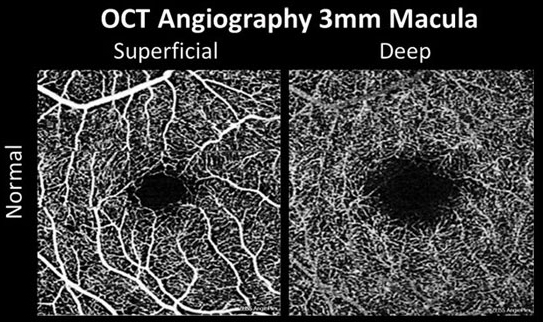 |
| OCT-A may be more reliable for measuring larger caliber vessels, as indicated in greater variability seen with the macula than with the optic nerve head. Photo: Carolyn Majcher, OD. Click image to enlarge. |
As investigated in one new study appearing in Vision, vessel caliber measurement repeatability matters clinically when attempting to use OCT angiography (OCT-A) for long-term monitoring. The small prospective study included 28 patients (47 eyes) who underwent sequential OCT-A imaging of both the optic nerve head and the macula. Two graders measured vessel caliber for sequential images of both structures.
The analysis included a total of 8,400 measurements of 420 vessels from 84 OCT-A images. Inter-grader agreement was excellent. Thinner vessels were associated with factors of greater glaucoma severity, older age, macular location and a diagnosis of diabetes. Variation was seen to be greater in the peripapillary region than in the macula, and correlation was high in all subgroups except for the macula.
Succinctly put, the study authors indicate that “the repeatability of vessel caliber measurements by OCT-A was high and variability low. There was greater variability in the measurement of macular vessels, possibly due to technical limitations in acquiring accurate vessel widths for smaller macular vessels.”
The authors note that previous studies have also looked at how repeatability of vessel caliber aligns with OCT-A. High repeatability has been found using spectral-domain OCT-A and swept-source OCT-A. However, as some prior research used vessel diameter index as a measure, which averages a value across an entire image, the authors caution that localized changes in vessel caliber and individual vessels may not be detected sensitively by this metric.
Specific to this study, although measurement variability of vessels around both the macula and disc were similar magnitudes, there was greater variability in caliber between vessels and the disc. As such, macula vessels accounted for a greater proportion of overall variability, with vessel caliber repeatability lower for macular retinal vasculature.
The researchers then explained their findings that thinner vessel width was associated with more severe glaucoma and higher variability for vessel width also in more severe glaucoma. Similarly, this is also consistent with previously conducted research across multiple studies that indicate an inverse relationship of vessel diameter and glaucoma progression. Their finding that diabetic patients had smaller vessels, however, is inconsistent with other studies that show larger arteriolar vessel calibers are associated with greater diabetic retinopathy progression.
All taken together, the authors posit that OCT-A does provide reproducible vessel caliber measurements when determining blood flow changes, but caution that “given the dynamic, pulsatile nature of the retinal microvasculature, higher-resolution imaging modalities may be necessary for parsing through the changes in vessel caliber for the smaller vessels comprising the macula.”
Tsai J, Asanad S Whiting M, et al. Repeatability and comparability of retinal blood vessel caliber measurements by OCTA. Vision. July 3, 2023. [Epub ahead of print]. |

